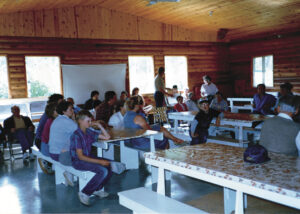Every winter, I hear a radio advertisement for a back-to-the-woods summer children’s camp in Ontario. The ad closes with the tagline, “You send us your child, and we’ll send you back a new one.” It’s a great slogan. It points out that renewal and transformation occur when people are pulled away from their daily routines to spend time in the great outdoors.
“You send us your child, and we’ll send you back a new one.” On the face of it, this slogan could apply to Mennonite church camps across Canada. We send our children to camp, and they come back renewed and transformed. They are usually radiant from the fresh air and exercise, bubbling with excitement. They often leave camp reluctantly, humming camp songs or chuckling to themselves in the car all the way home. They might ask about going back again next year.
The slogan is not perfect. Renewal and transformation do occur and, when we say those words as Mennonites, we are also talking about spiritual renewal and personal transformation because of the worship and faith-based discussions that are part of church camp life.
We understand transformation differently, but there is another reason why the secular camp’s slogan isn’t quite right for a Mennonite camp. It is that renewal and transformation are not even the best part of going. A Mennonite slogan would somehow capture that the best part of camp is the community. “You send us your children, and they’ll find a place to belong”.
One of our core convictions as Anabaptists is that we live out our faith in community with one another, offering mutual support, encouragement and accountability. Our nationwide vision statement says that we are called “to grow as communities of grace, joy and peace so that God’s healing and hope flow through us to the world”.
Camps offer communities of grace and joy, and they work towards peace. Have you noticed? They put together a disparate group of children into a cabin on day one and a week later send home kids who are tearfully hugging each other goodbye.
The camp community has a long-lasting pull. Most campers are keen to go back. As they get older, they stay in touch with camp friends during the school year. They might organize reunions or look for camp friends at larger church youth gatherings. As adults, they may go back as volunteers or help at fundraisers.
The church probably has something to learn from the camps. We would like people to experience renewal, transformation and a sense of belonging. We want children to identify the church as their community, and to become leaders who pass on the faith to the next generation. We would like that long-lasting effect on the people who come through our doors because it helps us carry out the larger mission of healing and hope.
Both camps and churches have been struggling with how to adapt to broad social change and demographic shifts in Canadian society. Among the changes are decreased interest in regular church worship attendance and fewer children in our families than in previous generations. The camps have responded by reaching out to new audiences. They have also been adapting programs and facilities to remain current and fresh.
Some churches are also adapting their model of being church. Mennonite Church Eastern Canada has a program called ReLearning Community that assists congregations in precisely this kind of church experimentation. Others worry that such changes mean we are losing our identity.
Look again at the camps. To remain viable, the camps have been willing to change programs and facilities but their mission and values remain the same. The camp culture lives on. They continue to excel at generating a sense of community.
Churches cannot completely emulate camps, of course. Our leadership and worship styles will not be as fun-focused and full of youthful energy. Sometimes we deal with weighty issues. However, camps reach out to attract newcomers and are very intentional at extending their welcome to all. They build strong communities that are able to keep up beloved traditions of the past while developing new ones at the same time.
For more on church camps, see here.
Corrections
- Miriam Sainnawap’s surname was spelled incorrectly and Mennonite Central Committee’s International Volunteer Exchange Program was misnamed in “MCC cuts Canadian programs to focus on advocacy,” Feb. 4, page 14.
- The photograph on page 30 of the Feb. 4 issue was taken by Jonathan Boerger. Incorrect information appeared in the “Indigenous art on display at the Grebel Gallery” news brief.
Canadian Mennonite regrets the errors.







Leave a Reply
You must be logged in to post a comment.